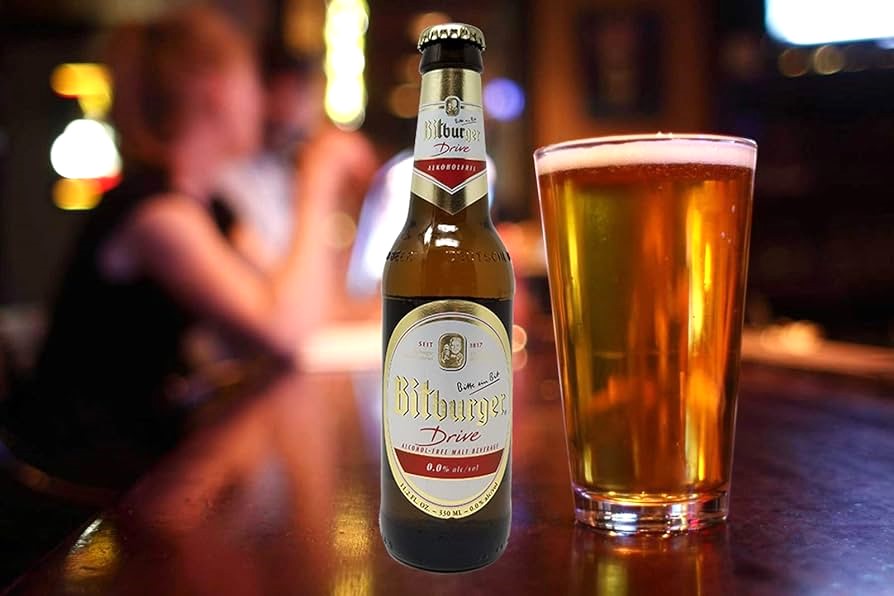Maybe that song by The Cars is more appropriate given my advocacy of Bitburger’s classic entry in the non-alcoholic sweepstakes.
In January each year the nation’s collective instinct for meek submission to its prevailing style arbiters results in a phenomenon of mass abstinence just prior to the annual Stupor Boll bacchanal.
As this exercise pertains to beer, Andy Crouch does not mince words at All About Beer, although the writer’s thoughts do not come without justifiable even-handedness: The Sober Truth: Most Non-Alcoholic Beer Isn’t Great.
I support the idea of non-alcoholic (NA) beer. I’ve long encouraged drinkers to routinely reevaluate their relationships with alcohol and I think Dry January is a noble and worthy exercise.
A related question: Did Dry January originate at TikTok? No matter; let’s go directly to the heart of Crouch’s argument.
While I had high hopes for NA beer, the results have been largely disappointing. The unavoidable truth is that most American non-alcoholic beer is pretty terrible and not worth drinking. Or worse, it can actually be dangerous. Producing NA beer is a pretty complicated, expensive, and oddly secretive process and few craft breweries have sufficient resources and dedication to do it properly. The result is that nearly every version tastes like one of two things: unfermented wort or some weird off flavor ridden version of the underlying style.
Crouch offers sound advice.
With the resources and time necessary to produce safe and palatable beers, the largest breweries–especially European ones–produce the best NA beers. For my money, Guinness 0.0 and Heineken 0.0 are two of the best options.
I completely agree with respect to Guinness 0.0. It probably the closest “taste-alike” to real beer I’ve ever experienced, which probably tells us as much about the low-gravity alcoholic flagship stout’s utterly impeccable balance than its non-alcoholic offshoot – and while I haven’t tasted Heineken 0.0, know that Bitburger Drive 0.0 has always struck me as a beer that tastes good, alcoholic or otherwise.
Overall, I think NAs are far better than ever before; as Crouch accurately notes, this isn’t altogether unexpected given the intrinsic olfactory futility of Sharp’s and O’Doul’s. But Crouch’s main thrust isn’t about aesthetics.
Unlike beer with alcohol in it, which inhibits the growth of nasty microorganisms like E. coli, listeria, and botulism, beer without alcohol is open to infection unless tunnel pasteurized, an expensive process often beyond the resources of smaller brewers, is employed.
As a good friend once observed, “ding ding ding.” Consequently, props to Cornell University for its recent, widely shared announcement, as precisely calculated to intrude upon the serenity of Dry January participants, thus generating maximum “reverse buzzkill.”
Nonalcoholic beer at higher risk for foodborne pathogens
“When you remove the alcohol, it’s really no longer a traditional beer,” said Randy Worobo, professor of food science in the College of Agriculture and Life Sciences and senior author of “Survival of Foodborne Pathogens in Low and Nonalcoholic Craft Beer,” publishing December 2023 in the Journal of Food Protection. “We suspected that foodborne pathogens would be able to grow without the presence of alcohol. We were correct. At that point, you must consider nonalcoholic beer like food and make sure that all parameters are met guaranteeing product safety.”
Here at Hip Hops, we’ve scanned various social media threads to gauge the reaction, and the words “denial” and “ignorance” top the chart.
That’s because the real issue is that all history in America exists primarily to be forgotten or misinterpreted. It comes as no surprise that people tend to dispense with the very fundamentals of Beer 101, as hammered home by Crouch: Alcohol makes our hops-flavored barley beverage safer, not the other way around.
Whatever their sugar source, alcoholic beverages are value-added products of agricultural aspiration, which obviously has been a prime consideration for human beings since it first occurred to them that there’s no future in starvation.
Gradually we humans have learned how to grow more food, preserve its nutrient value, and avoid foodborne illness. In olden times it was observed that the consumption of water sometimes caused people to become sick, although the precise reasons why remained elusive until the microscope was invented, and the proximity of latrines to water sources became a belated consideration.
Eventually science explained this connections, leaving organized religion (and Twitter) to dispute the findings in pursuit of their own social policy objectives.
It remains that boiling water as a necessary step in brewing beer kills harmful bacteria, and the alcohol created as a by-product of fermentation helps maintain the sanitary cordon. The ancient beverages mead and wine (using honey and grapes or fruit, respectively) also achieve a level of alcoholic strength that keeps the nasties suitably at bay.
(And, not coincidentally, this is why those Biblical figures of yore most assuredly were not drinking non-alcoholic grape juice to any significant degree, in spite of what your well-intentioned Sunday School teacher may have insisted you accept. Absent refrigeration, there’d have been no way to preserve the grape juice apart from fermenting it, and not only did fermentation preserve the value of grapes as an agricultural crop, but it also added a higher finished value when it came time for vintners to set up their booths at the farmers market.)
In short, raw grapes are rendered both stable and saleable once converted into wine, and the same is true of cereal grains and hops intended for beer, as well as the corn used to later produce distilled spirits like bourbon. In like fashion, prior to refrigeration perishable food items were preserved by drying, curing, pickling and smoking. The farm’s corn crop made whiskey and helped feed the pig; later, the farmer sold some of the bourbon and ham, and consumed the remainder himself.
Bearing in mind Crouch’s essay and Cornell’s study, I suppose there are two areas of concern as non-alcoholic beers pertain to pathogens: the liquid as originally packaged in cans and bottles, and the same liquid in draft form (as requiring systems to extract the liquid from kegs).
Resellers know that the former packaged NA should be kept cool insofar as possible upon arrival; I’ll leave considerations of non-refrigerated wholesale beer delivery fleet vehicles in high summer to a later tome. Conversely, now that barber shops, lawn and garden centers, Asian health spas and CBD dispensaries all seek to have 20-30 “craft” beers on tap, greater familiarity with draft beer cleanliness and sanitation might constitute the single most important takeaway from the Cornell study.
The researchers said that due to increasing consumer demand for nonalcoholic beer served on draft – or poured from a keg, for example – also could boost microbial problems. The group suggested that nonalcoholic beer kegs, draft-system tubing and beer-pouring faucets should be sanitized regularly to eliminate potential foodborne pathogens and spoilage organisms.
Presumably every commercial establishment with beers on tap cleans its lines regularly, irrespective of their alcoholic strength, right?
Supposedly, and yet we know best practices aren’t always followed. Cornell’s researchers remind you that disruptive microorganisms might find NA patches more conducive to mayhem, but really, the imperative to clean beer lines is perennial, and never ceases.
Verily, it’s always a “win” to advance useful knowledge about the history of beverage alcohol, thus wrestling our narrative from the leaden grip of prohibitionism.
Speaking personally, a beer without alcohol is not a beer, albeit no less marketable a product in the modern world while assuming the guise of “non-alcoholic, quasi-beer-like beverage.” I’ve always struggled mightily with this entire topic of non-alcoholic beverages that seek to taste like alcoholic beverages, and I mildly disagree with the columnist Crouch about the utility of “hop water” and the many other superfluous add-ons.
For me, if I’m choosing to refrain from consuming beverage alcohol, I’ve no interest in drinking faux beverages that at their best can only remind me of what I’m missing. Pellegrino works just fine for me, thank you, whether during a brief TikTok-inspired detox, or in the unlikely case of electing to abstain entirely; actually, in later life my consumption of alcoholic beverages as a whole has tapered dramatically compared with a periodically Falstaffian previous existence.
But, as always, to each their own, just like the notion of Dry January itself. At least the Patriots and Cowboys aren’t playing for the championship (again). We’ve got that going for us, if nothing else.
Photo credit: Bitburger Drive 0.0.
Previously at Hip Hops:
Hip Hops: Falls City’s new kitchen tenant will be (envelope please) Parlour Pizza



















 Roger Baylor is an entrepreneur, educator, and innovator with 42 years of beer business experience in metropolitan Louisville as a bartender, package store clerk, brewery owner, restaurateur, writer, traveler, polemicist, homebrewing club founder, tour operator and all-purpose contrarian.
Roger Baylor is an entrepreneur, educator, and innovator with 42 years of beer business experience in metropolitan Louisville as a bartender, package store clerk, brewery owner, restaurateur, writer, traveler, polemicist, homebrewing club founder, tour operator and all-purpose contrarian.


